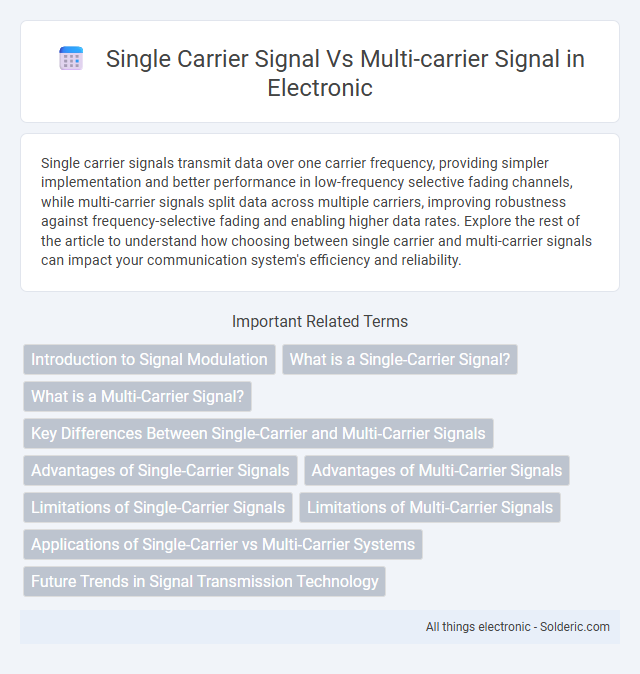Single carrier signals transmit data over one carrier frequency, providing simpler implementation and better performance in low-frequency selective fading channels, while multi-carrier signals split data across multiple carriers, improving robustness against frequency-selective fading and enabling higher data rates. Explore the rest of the article to understand how choosing between single carrier and multi-carrier signals can impact your communication system's efficiency and reliability.
Comparison Table
| Feature | Single Carrier Signal | Multi-Carrier Signal |
|---|---|---|
| Definition | Transmission using a single frequency carrier | Transmission using multiple frequency carriers simultaneously |
| Bandwidth Utilization | Less efficient for wide bandwidths | Highly efficient for wide bandwidths |
| Complexity | Lower complexity in modulation and demodulation | Higher complexity due to FFT/IFFT processing |
| Inter-Symbol Interference (ISI) | High susceptibility to ISI | Reduced ISI via guard intervals |
| Resistance to Multipath Fading | Lower resistance | Higher resistance due to frequency diversity |
| Peak-to-Average Power Ratio (PAPR) | Lower PAPR | Higher PAPR |
| Use Cases | Simple, narrowband communications | Modern wireless systems like OFDM, LTE, 5G |
Introduction to Signal Modulation
Single carrier signals utilize one carrier frequency to transmit data by modulating amplitude, frequency, or phase, offering simpler design and lower bandwidth requirements. Multi-carrier signals divide the data stream into multiple sub-signals, each modulated on different carrier frequencies, enhancing robustness against frequency-selective fading and improving spectral efficiency. Orthogonal Frequency Division Multiplexing (OFDM) is a common multi-carrier modulation technique widely used in modern wireless communication systems.
What is a Single-Carrier Signal?
A single-carrier signal transmits data using one carrier frequency, which modulates the entire signal amplitude, phase, or frequency to represent the information. This technique simplifies the transmitter and receiver design, making it ideal for low-complexity communication systems with narrowband channels. Your choice of a single-carrier signal may improve power efficiency and reduce signal processing requirements compared to multi-carrier systems.
What is a Multi-Carrier Signal?
A multi-carrier signal divides data transmission across multiple closely spaced frequency carriers, enabling efficient use of bandwidth and improved resistance to interference. Unlike a single carrier signal that modulates data onto one frequency, multi-carrier signals such as OFDM (Orthogonal Frequency Division Multiplexing) enhance robustness in multipath environments and support higher data rates. Your communication system benefits from multi-carrier signals by optimizing spectral efficiency and reliability in complex transmission channels.
Key Differences Between Single-Carrier and Multi-Carrier Signals
Single-carrier signals transmit data using one frequency channel, offering simpler modulation schemes and lower peak-to-average power ratio (PAPR), which improves power efficiency in mobile devices. Multi-carrier signals, such as those in Orthogonal Frequency Division Multiplexing (OFDM), divide the data into multiple subcarriers, enhancing resilience to multipath fading and inter-symbol interference in broadband communications. The trade-off includes increased system complexity and higher PAPR, affecting amplifier linearity and overall power consumption.
Advantages of Single-Carrier Signals
Single-carrier signals offer simpler transmitter and receiver designs, reducing hardware complexity and power consumption. They provide better performance in frequency-selective fading channels due to their lower peak-to-average power ratio (PAPR), which enhances signal reliability and efficiency. Additionally, single-carrier systems often experience less inter-carrier interference compared to multi-carrier systems, improving overall communication quality.
Advantages of Multi-Carrier Signals
Multi-carrier signals provide enhanced spectral efficiency by dividing the available bandwidth into multiple orthogonal subcarriers, reducing inter-symbol interference and improving resilience to frequency-selective fading. Your communication system benefits from increased data rates and better performance in multipath environments due to the robustness of multi-carrier modulation techniques like OFDM. This leads to more reliable signal transmission in wireless and broadband applications compared to single carrier signals.
Limitations of Single-Carrier Signals
Single-carrier signals face limitations such as susceptibility to inter-symbol interference (ISI) in multipath fading environments, which degrades signal quality and data integrity. They require complex equalization techniques to mitigate channel distortion, increasing system complexity and processing power. Your communication system may also experience reduced spectral efficiency compared to multi-carrier signals, limiting bandwidth utilization in high data rate applications.
Limitations of Multi-Carrier Signals
Multi-carrier signals face limitations such as high peak-to-average power ratio (PAPR), which leads to inefficient power amplifier usage and increased signal distortion. They are more susceptible to inter-carrier interference (ICI) in frequency-selective fading channels, requiring complex equalization algorithms. These factors result in higher system complexity and increased power consumption compared to single carrier signals.
Applications of Single-Carrier vs Multi-Carrier Systems
Single-carrier systems are widely used in applications requiring low peak-to-average power ratios, such as satellite communications and traditional voice transmissions, ensuring efficient power usage and simpler receiver design. Multi-carrier systems, like OFDM, dominate broadband services including Wi-Fi, LTE, and 5G, due to their robustness against multipath fading and ability to handle high data rates in frequency-selective channels. Your choice between single-carrier and multi-carrier systems depends on the specific communication environment and performance requirements, balancing complexity, bandwidth efficiency, and signal reliability.
Future Trends in Signal Transmission Technology
Single carrier signals offer simplicity and robustness against Doppler shift, while multi-carrier signals like OFDM enable higher data rates and better spectral efficiency, crucial for emerging 5G and 6G networks. Future trends emphasize adaptive multi-carrier transmission with machine learning to optimize bandwidth and reduce interference, meeting the demands of ultra-reliable low-latency communication (URLLC). Your network performance can significantly improve by leveraging flexible multi-carrier architectures that accommodate diverse applications in IoT and beyond.
single carrier signal vs multi-carrier signal Infographic

 solderic.com
solderic.com